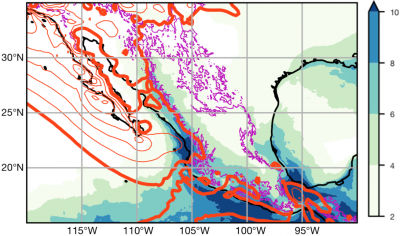Making a Monsoon from an Orographic Stationary Wave
A band of intense rainfall extends more than 1,000 km along Mexico's west coast into the U.S. Southwest during summer, constituting the North American monsoon. As in other tropical monsoons, this rainfall maximum was commonly thought to be thermally forced by the emission of heat from land and elevated terrain into the overlying atmosphere. As part of a Department of Energy project, researchers at the University of California Berkeley showed that the core North American monsoon is instead generated when the Sierra Madre mountains deflect the extratropical jet stream toward the equator, mechanically forcing eastward, upslope flow that lifts warm and moist air to produce rainfall. These findings were based on analyses of dynamic and thermodynamic structures in observations, global climate model simulations, and theoretical solutions for the effect of mountain ranges on the jet stream.
Monsoons are continental-sized atmospheric wind patterns that supply water to billions of people and set the climate of large swaths of Earth’s surface. The North American monsoon, in particular, is crucial for the hydrology of western Mexico and the southwestern US. This research overturns the prior understanding of the fundamental science of that monsoon, placing new emphasis on the jet stream and its interaction with mountain ranges. This has implications for projections of future trends in North American rainfall, making changes in the extratropical jet stream of central importance and deemphasizing the relevance of the land-ocean contrast in thermodynamic properties.
The North American monsoon, which supplies water to much of Mexico and the U.S. Southwest, was previously thought to be caused by intense heating of the atmosphere by the land surface during summer. This study overturned that longstanding idea, showing that intense monsoon rainfall is instead generated when mountain ranges along the west coast of North America deflect the extratropical jet stream toward the equator. This creates eastward flow up the slopes of those mountains, lifting warm and humid air to produce abundant rainfall. These results have implications for future changes in North American monsoon rainfall, making trends in jet stream interactions with orography of central importance.

